Soon after you leave the airport in Havana, will you see huge paintings and posters by probably the most iconic freedom fighter in the world, “Che Guevara.”
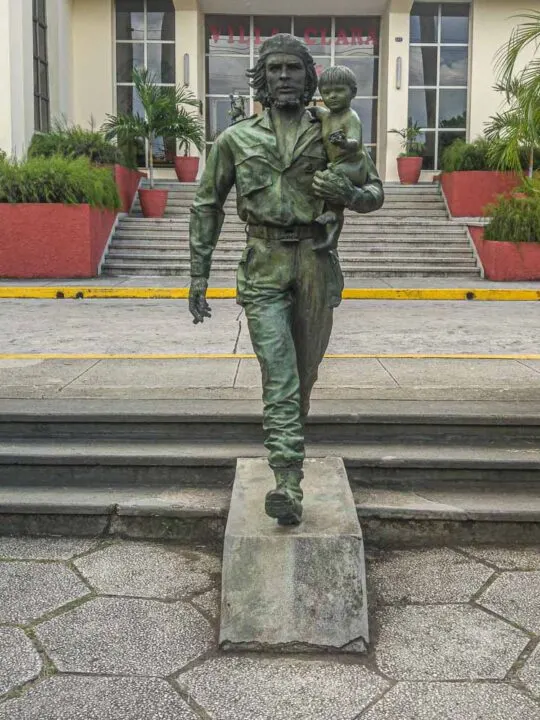
But it wasn’t in Havana that El Che made its legacy. It was in the city of Santa Clara, in Central Cuba. So it’s easy to understand why El Che” Guevara’s Mausoleum was built here.
Santa Clara is where the Cuban Revolution was made (but not where it started).
Santa Clara sits in the heart of Cuba, around 4 hours drive from the capital Havana. It’s well-known for the role it played during the Cuban Revolution and is often referred to as the ‘City of Che Guevara.’
The city was founded by a group of families in 1689, and today, it’s a vibrant spot with lively bars, music, and colorful buildings, but today the city is most famous for being the home to the Che Guevara mausoleum.
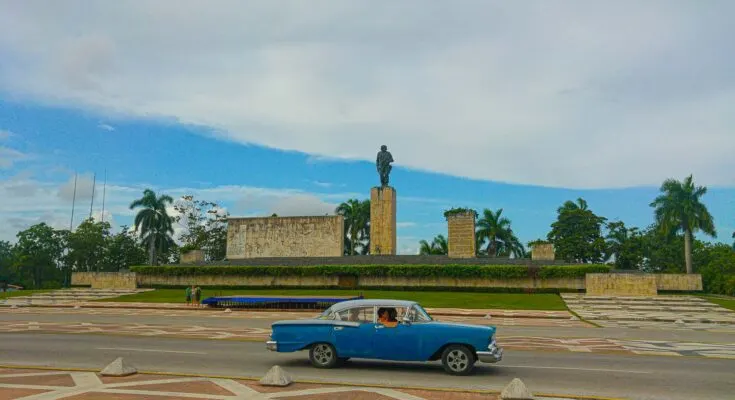
But Santa Clara is more famous for being the place where an epic battle was fought on 29th December of 1959.
18 men under Che’s command, armed with rifles, homemade Molotov Cocktails, and a stolen Bulldozer derailed an armored train with 350 soldiers that the current President Fulgencio Batista had sent as reinforcements.
But Che and his men managed to derail and capture all the 350 soldiers on board the train, without even firing a single bullet, the train was also transporting a big amount of weapons that Che and his men would use later in the Revolution.
Booth the Bulldozer and the derailed train is on display these days in a memorial park in Central Santa Clara.
Top Things To Do In Santa Clara
Learn about the Cuban Revolution at Tren Blindado (Armoured Train)
Towards the final days of the Battle of Santa Clara, when Castro had taken the city, Batista sent almost 400 armed soldiers with ammunition for several months to overthrow Castro and his military.
As the train approached Santa Clara, it stopped at the foot of Loma del Capiro, and eighteen men led by Che Guevara attacked the train.
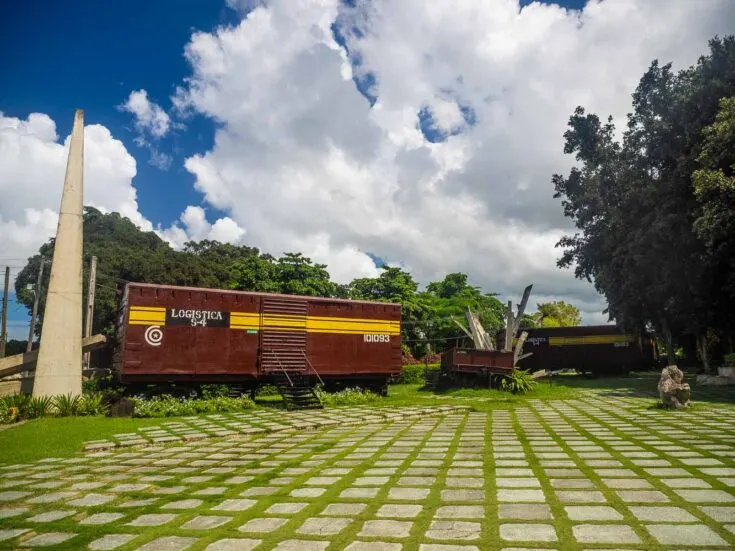
When officers on the train attempted to move it, Guevara’s men derailed the vehicle by destroying a long stretch of track with a bulldozer.
Later that day, acknowledging defeat, Batista’s officers surrendered to the rebels, with many becoming friends.
Today, visitors can relive the drama and begin to understand what happened on that day by viewing the sculpted replica of the derailed train, monuments to Che Guevara, and even the bulldozer!
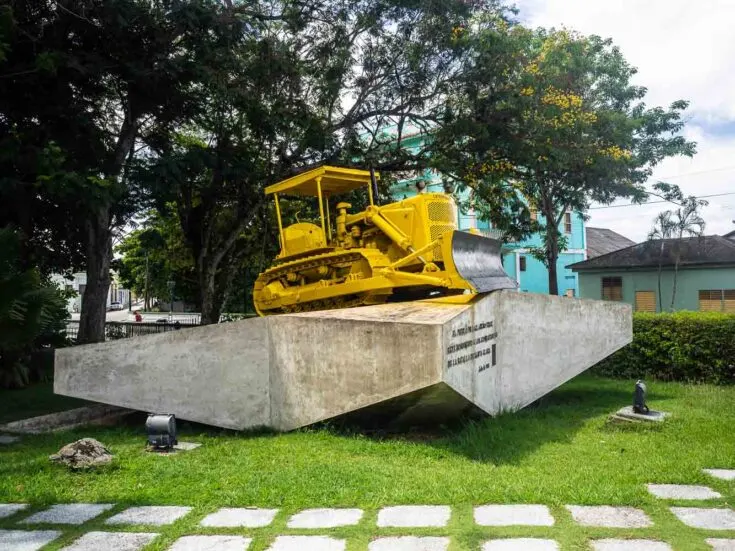
Spend Time at the Che Guevara Monument & Mausoleum
The Mausoleum is located on the western outskirts of the city, it’s an easy 30-40 min walk between those two places.
The Che Guevara Mausoleum (Mausoleo Che Guevara) was opened in October 1997, 3 decades after his death in Bolivia on 9th October 1967.
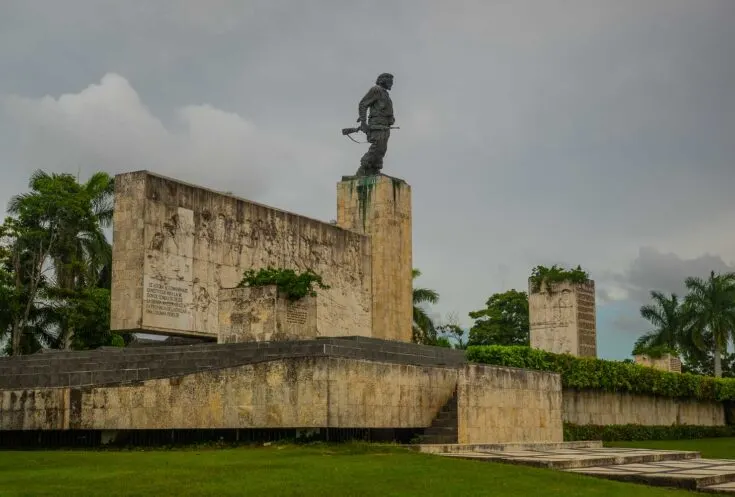
The Mausoleum also holds the remains of 6 of his fellow guerrilla soldiers that were killed together with him in Bolivia. None of the remains is on display.
There’s an Eternal Flame lit by Fidel Castro in the memory of Che Guevara.
There’s also a small museum dedicated to Che’s life next to the Mausoleum. It holds some of Che’s personal artifacts, like the actual camera he used on his South America bike trip, some of his uniforms, a few of his weapons, plus a lot more.
There’s a STRICT no photo policy inside the Mausoleum and museum, you will have to leave your camera and phone, together with your backpack, at the entrance.
Because of the strict no photography rule inside the Mausoleum and museum, there are not that many photos to share from this place.
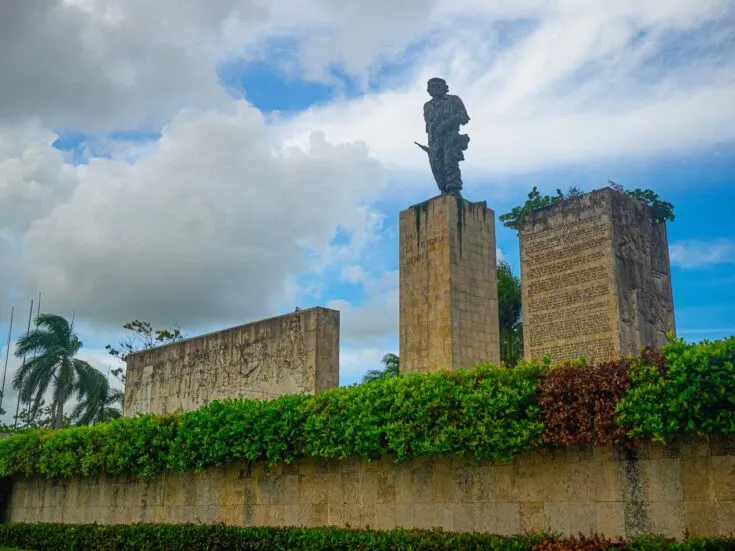
There’s free and safe bag storage just outside the mausoleum compound. There’s also a clean, free public toilet here.
Americans are, technically at least, not allowed inside the museum and Mausoleum, you will be asked about your nationality when entering.
However, they don’t ask for ID.
So if you are American, you will have to lie and say yours from another country. An American couple got refused entrance while I was there.
Booth the Mausoleum and Museum are totally free of charge to enter.
On top of the Mausoleum is the 22ft/6,7m tall bronze statue of Che is referred to as the Ernesto Guevara Sculptural Complex there are reliefs and inscriptions, relating to historic events.
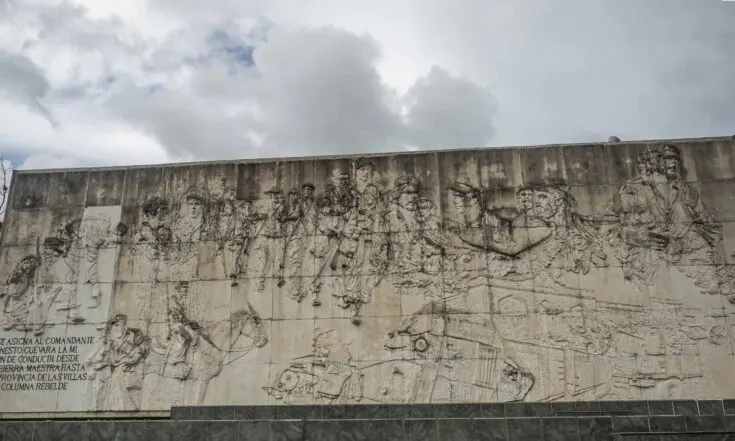
You will notice there are a lot of locals hanging out at the big public square in front of the Mausoleum, they are not Che pilgrims, but local´s hanging out for the WIFI (Not free)
This revered national memorial in Plaza Che Guevara is home to the remains of the revolutionary and 29 of his compadres who lost their lives during the Bolivia uprising.
The main monument is said to point 190 degrees towards South America, symbolizing a united continent free from war.
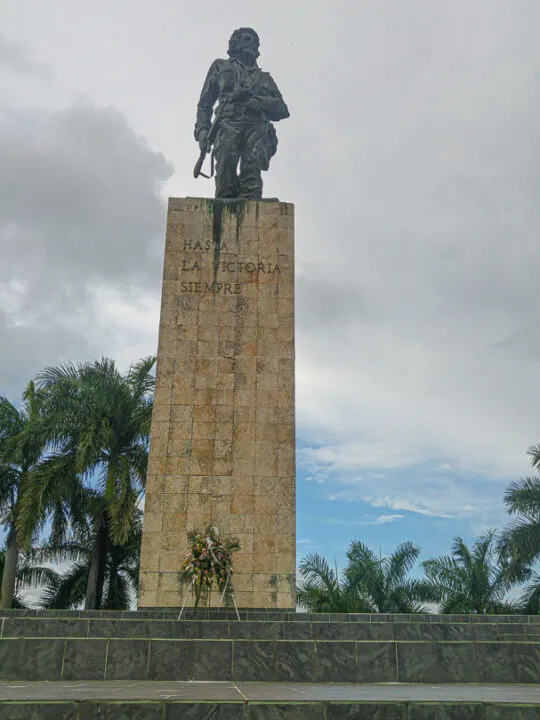
NB. Che Guevara found his second wife in Santa Clara, Aleida March which he also had 4 kids with.
Soak up the Atmosphere in Parque Vidal
Santa Clara is not a large city, therefore it’s easy to navigate on foot. One of the first places you’re likely to encounter on arrival is Parque Vidal, set in the center.
Fringed by beautiful colonial and neo-Classical style houses in varying shades of pastel, the leafy park offers welcome shade from the midday sun with benches dotted around a bandstand.
Old men play competitive games of chess as the sound of plates clatter from nearby restaurants and bars.
There are statues of local figures to discover, and later in the day, live music plays as people dance freely till well after the sunsets.
Dine in a Cuban Paladar
Paladares are private, family-run restaurants operating out of residential houses throughout Cuba.
If you find one which is super authentic, you’ll be dining on the menu of the day, in other words, whatever the host is serving!
Traditional Cuban dishes include ‘ropa vieja’ – slow-cooked shredded beef with a mix of peppers, onions, and tomatoes, ‘yuca con mojo’ – pre-Hispanic root vegetable with a tangy sauce or ‘ajiaco’ – a hearty stew packed with meat and vegetables.
There are several of these establishments in and around Santa Clara, so if you want to experience authentic cuisine and Cuban hospitality, look for a sign that says ‘Paladar.’
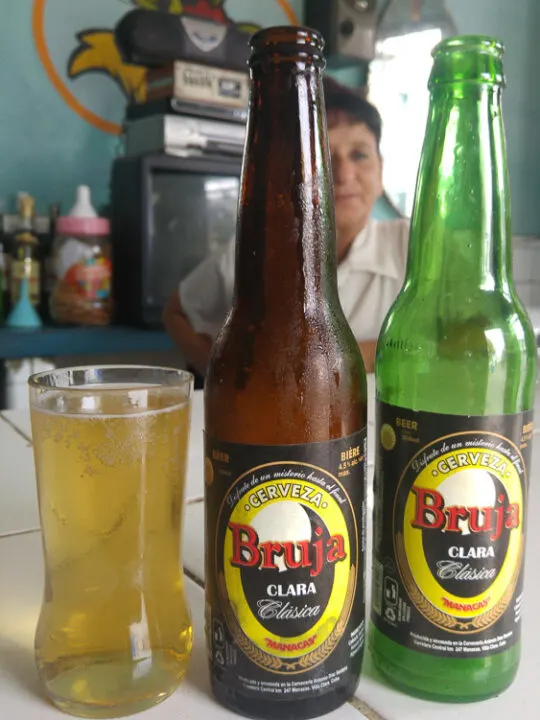
Experience a Santa Clara Festival
Santa Clara residents love a good party, and throughout the year, there are several festivals held in the city.
The fun kicks off in early January with Festival de la Trova – a local music fiesta dedicated to the ‘Trova’ musical genre made famous by local composer Manuel Corona.
This is then followed by a variety of theatre, dance, and film festivals and concludes with the Festival de Invierno or Winter Festival later in the year.
Whatch a Baseball Game
Santa Clara, although a small city, has a national league baseball team that plays regularly throughout the season at Estadio Sandino.
The atmosphere on game day is electric in the city, plus, it’s a cheap way to spend a few hours!
You can mingle with locals in the stands and cheer for the local team before heading to a nearby bar for drinks.
Experience Santa Clara Nightlife at El Mejunje
In 1991, local businessman Ramon Silverio was offered a crumbling ruin in the center of Santa Clara.
Initially, it was to be utilized as a venue for theatre performances, film, and live music – it even hosted the odd kid’s morning and afternoons for senior citizens!
However, as the venue evolved, it became well-known throughout Cuba – an iconic landmark for a new style of nightlife with live Trova music nights, effervescent drag shows, and Afro-Cuban dancing.
The venue is unique, with no roof, twisting vines, and exposed brick walls covered in graffiti, and it’s one place you should experience during your stay in Santa Clara, Cuba.
See a Performance at Teatro La Caridad
Teatro La Caridad sits inside a beautiful 19th-century colonial-era building in Santa Clara. Located near Parque Vidal, it’s worth visiting solely for the architecture alone!
Marta Abreu de Estevez, a writer from the city, constructed the theatre as a gift to the city’s residents, and as it is built on the site of a historic chapel, there are little details inside that highlight its original heritage.
The theatre has, in recent years, become one of the most reputable centers of culture on the island and has hosted performances from national stars across the art scene.
Discover How Cuban Cigars are Made
Santa Clara’s cigar-making factory is just a short stroll from the town center and most accommodations.
The factory itself is quite basic and much smaller than those of Havana and Pinar del Rio, but it does give great insight into the whole cigar-making process and highlights the tough work the employees do.
Rows of wooden desks are laid out with everything needed to fill, roll and press the cigars, and with over 100 brands and sizes to make, the workers are trained extensively over several years.
If you’re interested in Cuban cigars or simply wish to pass the time for an hour, then it’s worth a visit.
Walking Tour of Santa Clara, Cuba
If you’re planning a walking tour of Santa Clara, start at Parque Vidal and the wall murals painted next to the local newspaper office.
The comic-strip style murals are the work of a city artist collective telling stories of residents’ lives, Cuban history, and local politics.
They offer a glimpse into Cuban life and their visions for the future.
There’s also the Old Colonial Town to visit – great for shopping and eateries serving some of Cuba’s delicious street foods, followed by a leisurely stroll to the Che Guevara statue on Avenida Liberación.
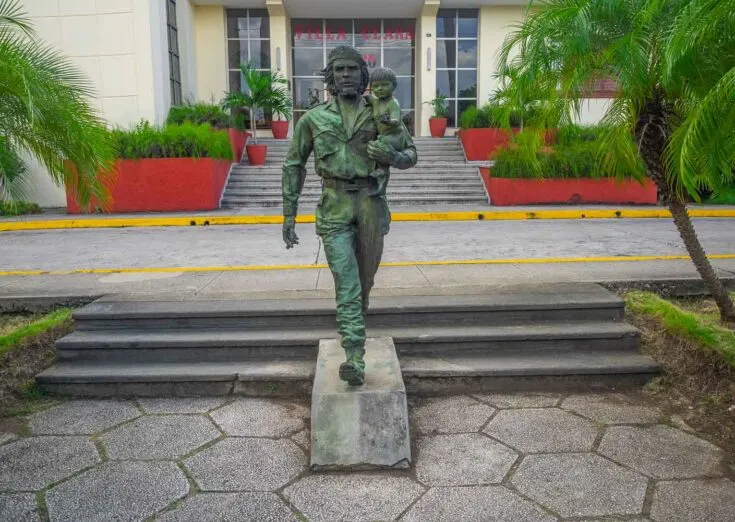
Hike to Loma del Capiro
Loma del Capiro has the best views of Santa Clara. This trio of small peaks gained significance after it was used by Che Guevara as a hideout and viewpoint to spot approaching military during the Battle of Santa Clara.
Atop the hills, you can overlook the entire city skyline sprinkled with palm trees, and further into the distance, plantations and farms form a patchwork of green.
During your visit, you can view old trenches and monuments, and unbeknown to many, these hills are also home to endemic species tucked away in the savanna and forests of the northern slope.
The southern slope is dotted with tamarind trees, providing natural shelter and fruit for local communities.
Step Back in Time at Café Museo Revolucion
This café diner/museum is a quirky retro place where you can pop in for coffee and snacks whilst stepping back in time.
Adorned with black, white, and sepia photographs of Cuba’s military personnel and a whole host of retro artifacts, this café portrays Cuba in the 1950s with antique petrol pumps, old-style telephones, flags, and metal wall signage.
Sip a frothy coffee and enjoy a grilled cheese sandwich as you admire myriad artifacts and imagine what it was like to live in Santa Clara during this era.
Enjoy a Beach Day at Cayo Santa Maria
Just over 1.5 hours’ drive east of Santa Clara is the beautiful beach of Cayo Santa Maria. Set on an island joined to the mainland by road, it’s an idyllic place with white sugary sands and palm-fringed beaches.
There are a few hotels, it’s safe for swimming, plus, there are abundant water sports, a nature reserve, and even a couple of casual waterfront restaurants to enjoy!
How to Get to Santa Clara, Cuba
Public transport in Cuba can be inconsistent, although the services are improving every year. The good news is most transportation is cheap, and there are several ways to travel to Santa Clara from Havana and beyond.
Flying to Santa Clara Cuba
Abel Santamaria Airport lies 11 kilometers north of Santa Clara and can be accessed by airlines from many islands in the Caribbean and throughout the Americas.
Air Transat operates a weekly flight from Toronto and Montreal to Santa Clara, Cuba, however, most European flights arrive in Havana or Varadero a few hours away.
If you are fortunate enough to fly directly to Santa Clara Airport, the taxi cost from the airport to the city center is between 10 and 12 euros. Alternatively, you can hire a car if you book well in advance.
Bus from Havana to Santa Clara Cuba
Viazul buses are comfortable, air-conditioned, and operate from Havana, with a journey time of around 4 hours. Tickets can be purchased in advance.
Trains to Santa Clara Cuba
Santa Clara train station is on the mainline from Havana to Santiago. Although the train to Santa Clara from Havana is cheap – around 1-2 euros one-way, the service only operates every few days on demand. From Havana to Santa Clara via Matanzas, the journey time is approximately 6 hours.
Travelling from Trinidad to Santa Clara Cuba
If you are planning to travel from Trinidad to Santa Clara, Cuba, buses, and taxis offer services, although the latter can be expensive, or there’s also the option to drive in around 1.5 hours.
Getting Around Santa Clara Cuba
Santa Clara is not a huge city, therefore easy to access on foot, plus, there are taxis and carriages operating in the city centre.
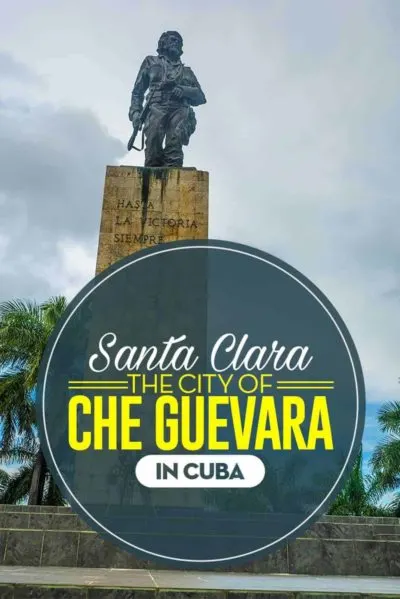

Ray
Friday 14th of October 2016
I wasn't aware that Americans aren't allowed in the Mausoleum until now. Mind you, when I was here a couple of years ago, the museum was closed due to inclement weather. My tour group ended up spending the afternoon strolling through Santa Clara instead, which was a very unique experience in itself (i.e. one of the most non-touristy places I've ever been). Will be interesting to see how long it will be before those rules change as American tourists start to come down to Cuba over the next few years as a result of the renewed relationship between the United States and Cuba.